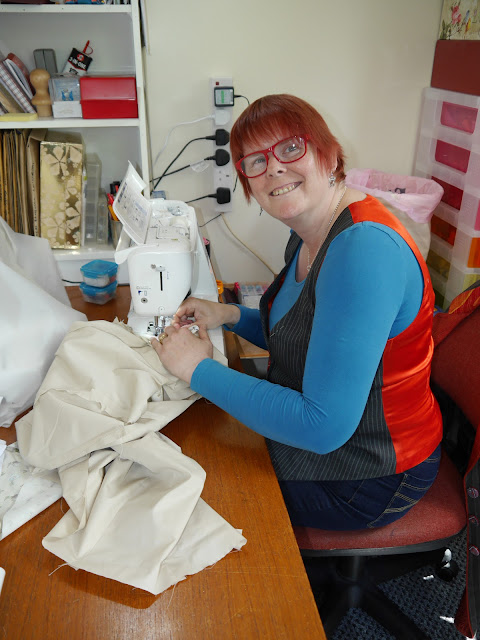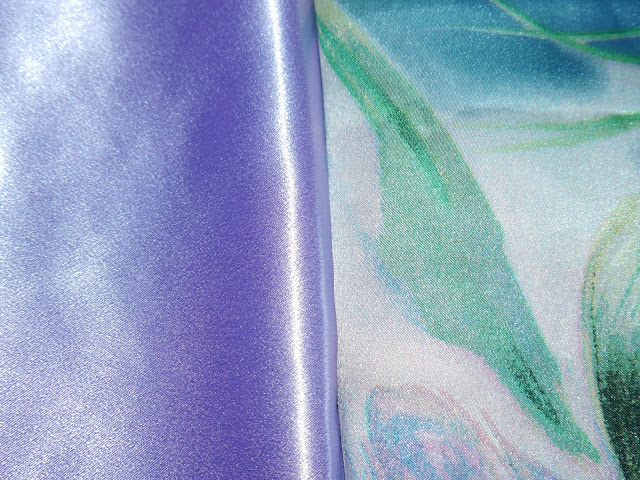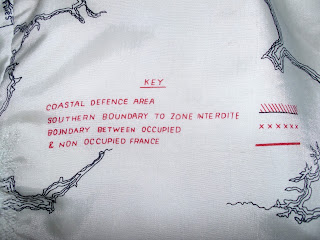What is Interfacing?
Interfacing is the underpinning inside a garment. It can be bonded to the wrong side of the fabric, this is called Iron On. Or, it is sewn to the wrong side of the fabric, this is called Sew In. There are a number of functions for interfacing a garment, these are;
- Add strength
- Add structure
- Add weight
- Change the characteristics of the fabric
If you are new to sewing you might visit a fabric outlet and be a bit bamboozled by the collection of Interfacings on offer, you will be asked whether you want Iron On or Sew In, what weight you need and whether you want woven or non-woven, natural fibre or synthetic? It’s a bit confusing to begin with until you have more experience, or until you get some information from the back of a pattern envelope. The directions there will only give you one option, usually iron on and you will be told to get light, medium or heavy weight.
I use all sorts of things as interfacings, according to what the fabric a given project is made out of and what properties I want to introduce or bring out of that fabric – it’s amazing what you can do to change the characteristics of your cloth.
Start off with a few questions.
What is the fibre you are using, wool, silk, cotton, mixed fibres, synthetics?
- How thick is your fabric?
- How does your fabric behave?
- How do you want your fabric to behave?
- What sort of garment are you making?
- How much structure do you want to create?
This might seem complicated, but if you ask the questions before you purchase any cloth, production will be more straight forward and you will feel more confident that the finished project will look how you want it to. So let’s address each question in detail.
1 – What is the fibre you are using?
Wool is very malleable with steam so whether you are using Iron On or Sew In, that too needs to be mouldable. Knitted Iron On is ideal.
Silk is easily marked by the adhesives in Iron On – DON’T, unless you are sewing with raw silk of medium/heavy weight. With silk you can use lots of different things as a Sew In interfacing. For Dupion either get enough of the silk to use it as both main fabric AND interfacing if you want to retain it’s crispness, or use another fabric which has a softer fall to help it move more freely with the body. My favourite is Wool Chalice which is a soft, loose woven very fine wool that also helps to prevent the garment creasing so easily, it can be almost as expensive as the silk though. Another cheaper option is a good quality synthetic Crepe Back Satin, usually around £5-£10, which also gives the silk a bit of weight too. Crepe back satin is also brilliant to use with Taffeta, silk or synthetic, which also marks easily.
Cotton is great with either Iron On or Sew In, if you want to stiffen your garment use Iron On, if you want the structure without the crispness use Sew In.
Mixed fibres and synthetics act pretty similarly, with heavier weights you could use Iron On. However, I tend to use Sew In simply because it ultimately looks better.
2 - How thick is your fabric?
You need to match your interfacing with your fabric, fine fabrics – fine interfacing, heavy fabrics – heavy weight interfacing.
3 – How does your fabric behave?
Unless you really want to change the handle of the cloth you are using you need to match the softness, stiffness or whatever the quality of the fabric, with the interfacing.
4 – How do you want your fabric to behave?
Big question.
You can radically change how your cloth will behave with the interfacing you use.
To stiffen, use Iron On or a crisp Sew In, the best of these is made with Horse Hair which is wonderful for tailored garments and for building up structure.
To stabilise a loose woven cloth use an Iron On, this is an especially good idea with cottons made in the Middle and Far East.
To add weight use a Sew In of some description, you can match it fibre for fibre or use something very different depending on what you have to hand and what your budget is.
To soften use a loose woven Sew In cloth that has a very soft handle.
5 – What sort of garment are you making?
Structured clothes need the best, horse hair and calico used in layers to build up shape and structure underneath the outside fabric such as in tailored jackets, this is an art form in itself and needs practice (if you want to learn about this kind of making I can recommend an amazing book – Vintage Couture Tailoring by Thomas Von Nordheim, ISBN – 978-1-84797-373-3).
Dresses with structured bodices need a good Sew In, my favourite for this is cotton curtain lining, it’s perfect, it has strength and costs very little.
For collars, cuffs and facings use a good quality Iron On (unless you are using Silk Dupion), my favoured ones are; Vilene super soft heavy weight (which has stitching running through it) and is suitable for most fabrics because it is really soft, and knitted Iron On. These two are a little more expensive than average but worth every penny.
Shirt cuffs & collars, Iron On Buckram (a really stiff interfacing which you can get as Sew In or Iron On, and it’s great for bag making too) will give you a really nice stiff effect more akin to commercial shirts.
6 – How much structure do you want to create?
Most patterns will tell you to use an Iron On of a specific weight, you might want to change that for a better quality Sew In and use it in layers, boning (covered is best), or add decorative top stitching as well to make really great shape and structure.
Woven or non-woven
Vilene is an example of non-woven, created by layering synthetic fibres on top of each other and heat bonded together. If you use Non-woven I would only recommend the brand Vilene, it is the best quality and behaves as you want it to. There are cheaper brands but I wouldn’t give them house room personally.
You can use any woven fabric as an interfacing; you just have to match the cloth you use to the properties you want. You can buy really high quality horse hairs, wool and cotton interfacings from MacCulloch and Wallis in Soho, London. They have several floors of goodies and are well worth a visit.
By now you have got the gist that pretty much any fabric can be used as an interfacing so here are some examples of what I have used lately.
 |
Stabilised Mutka Silk
This lovely cloth is really soft with a loose weave and needs a bit of a helping hand to be used in jackets so this was stabilised with a light weight Iron On interfacing.
|
 |
| Vilene super soft heavy weight |
This stuff is amazing, you can use it on all but the lightest weight cloth and it behaves really well on cotton and wool.
 |
Knitted Iron On
This is a really good quality Iron On and works brilliantly with loose woven Eastern fabrics and wool coating/suitings as it retains flexibility more than any other Iron On.
|
 |
Horse Hair
Especially good for tailoring as you can build it up and manipulate it to create structured shaping.
|
 |
Calico, unbleached cotton that is rather crisp/stiff
Calico is very strong and crisp or stiff according to the weight you use, however, it creases like mad so use only with horse hair in the layers for a tailored garment. For example when building up the shoulders, this will help keep the cost down as it is much cheaper than horse hair so use it in alternate layers.
Silk Dupion
I am using this at present in a bespoke waistcoat for a client.
This is the wrong side of the top collar and revers of the waistcoat
For the top collar and the back neck facing I had enough of the top fabric, but the revers have been interfaced with a bit in another colour left over from another project.
The collar, revers and back neck facing on the right side
You can see that using a Sew In with silk Dupion is really the only option. There is a risk with Iron On that the dots of adhesive will end up coming through the silk when you press the garment, which you really don’t want. So to preserve the perfection of the silk stick with Sew In. I wanted to preserve the crispness of the Dupion which is why I have used it as the interfacing too.
This is the rest of the waistcoat, made with Indian cotton
As I was saying earlier, loose woven cottons from India and other Eastern countries can be very difficult to work with; they fray, stretch and distort easily. To stabilise it and preserve malleability I have used the knitted Iron On, makes my job my easier and saves time ultimately.
Applying Interfacings
Iron On
You will need a set of new Egyptian cotton or Irish Linen tea towels, two for white interfacing and two for black interfacing. Using these to protect your ironing board and your Iron will allow you to use plenty of heat and steam to make the adhesive work more effectively. You will also need to allot one of your set of two for the top and one for the bottom, the bottom one will get more adhesive on it. To clean your towels you will have to boil them every so often, literally stick them in a big pan with washing powder (better for boiling) and simmer them for at least 30 minutes – you won’t get it all out but it will be better.
- Cover your ironing board with your bottom tea towel
- Put your piece of fabric right side down on to the tea towel
- Place your Iron On interfacing adhesive side down on to the fabric – the adhesive side is either shiny or knobbly
- Cover with your top tea towel
- Steam with your iron on a hot setting and press, you need to give it a really thorough press/steam for the adhesive to work properly
- Remove the top tea towel and allow to cool for a few seconds before lifting your bonded fabric off the bottom towel.
Now it is ready to use.
Sew In Interfacing
- Cut your interfacing exactly as you would your main fabric for woven interfacings, i.e. using your pattern pieces, the grain line and pin 5cm apart then cut carefully.
- Pin to the wrong side of your fabric piece.
- Sew all around the edge, using a stitch length of 3-4mm, 5mm in from the edge of the fabric ensuring you don’t let the stitching pucker the fabric, so check the tension on a scrap first.
Now it is ready to use.
Where to buy Interfacings
You can buy interfacings in any fabric retailer, for Iron On, it is worth paying for good quality, Vilene is the best non-woven by far and there are a number of brands of knitted Iron On. With Sew In, just experiment. You will discover your own favourites if you get some scraps and try them out on small projects.
For the best of the best you can’t beat MacCulloch and Wallis, they have the greatest variety and highest quality for a special project.
If you do lots of sewing it is a good idea to invest in whole rolls of Iron On – they are usually 25 metres; you will get a decent discount by doing that which will save you in the long run.
I hope you are no longer confused and feel confident to make the right choice of interfacings for your projects. Happy sewing.
|













































